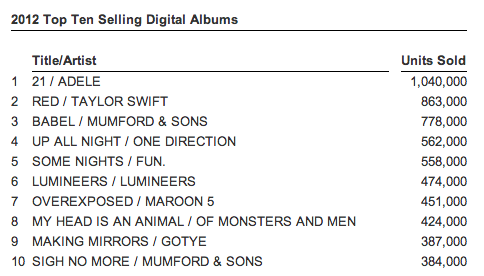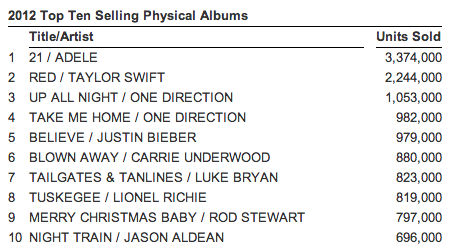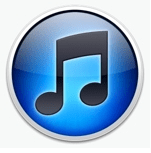Today news broke that Spotify was halting its music download service in favor of pushing more of its streaming services — raising some questions about how well downloads are doing compared to streaming music. But whatever way you cut it, digital music, and digital music purveyors, now dominate the music business, according to new research out from Nielsen (embedded below).
In the analyst group’s annual music industry report, compiled by Nielsen SoundScan and Nielsen BDS, it found that digital music now accounts for 55.9% of all music sales in the U.S. — including both full albums as well as track-equivalent albums.
This is also the first time that digital music stores outpaced physical stores for album sales. iTunes, Amazon, eMusic and others combined to account for 37% of all album sales. Nielsen notes that “Mass Merchants” like Walmart and Target (and physical albums) had led in this category for the last five years; this year their share was only 29%.
In a year where overall sales of in the U.S. albums and track equivalents were down by 1.8% compared to 2011 — Nielsen does not provide the actual monetary figure for how much revenue was generated overall — overall music sales, which include single tracks as well, were up by 3.1%. Digital continues to be the driver of that: digital album sales are up by 14% and digital tracks up by 5%, compared to a decline of 13% in CD sales.
Physical, however, remains the dominant album format — meaning that a lot of those digital sales are in the area of tracks rather than albums. More specifically, digital albums sold 117.7 million units, and digital tracks were at 1.34 billion units.
This was also the year that single individual digital tracks saw more than 6 million downloads in the year. Two songs collected that accolade: Gotye’s “Somebody That I Used to Know” at 6.8 million downloads, and Carly Rae Jepsen’s “Call Me Maybe” at 6.5 million. Fun’s “We Are Young” nearly hit 6 million with 5.9 million downloads.
“Overall music purchases surpassed 1.65 billion units in 2012, up 3.1% vs. the previous record high set in 2011, driven by digital music sales, which continue be a key growth element within the market,” writes David Bakula, SVP Client Development, Nielsen.
But while digital is driving the overall music business, we have yet to see parity in terms of the demographics that use digital avenues for their music consumption.
Looking at the top albums in physical versus digital, for example, Adele’s 21 and Taylor Swift’s Red top both at numbers one and two respectively. But further down you can see more of a leaning to mainstream artists in physical, with alternative in digital. Mumford and Sons and Gotye don’t get a look in the top-10 in physical, and Bieber is nowhere in the digital list. Also, the top ten volumes are simply much higher still in physical compared to digital.


That is slowly starting to change. While ‘alternative’ remains to most popular category in digital, Nielsen notes that the fastest-growing at the moment is country music, up by 38% compared to the overall average growth of 14%.
In the area of individual tracks, dance and electronic music topped the list with sales of these up 36%.
